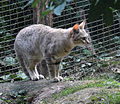There are no bones of the Holocene dwarf fauna present in Shillourokambos. Shillourokambos is also the site where the oldest evidence of human domestication... 5 KB (634 words) - 05:29, 30 August 2023 |
 | periods, including Preneolithic (Akroteri culture), Early Neolithic (Shillourokambos culture), Neolithic I, Neolithic II (Sotira culture), Chalcolithic... 22 KB (1,197 words) - 07:24, 22 April 2024 |
 | Çayönü, Cafer Höyük, Aşıklı Höyük, Kissonerga-Mylouthkia [de] and Shillourokambos. Definitive evidence for the full domestication of emmer wheat is not... 26 KB (2,946 words) - 18:44, 21 March 2024 |
 | houses with floors made of terrazzo of burned lime (e.g. Kastros, Shillourokambos) and cultivated einkorn and emmer. Pigs, sheep, goats and cattle were... 51 KB (6,489 words) - 13:10, 28 April 2024 |
 | houses with floors made of terrazzo of burned lime (e.g. Kastros, Shillourokambos, Tenta) and cultivated einkorn and emmer. Pig, sheep, goat and cattle... 31 KB (4,131 words) - 13:10, 28 April 2024 |
 | according to archeological evidence from the Neolithic village of Shillourokambos on the Mediterranean island of Cyprus. Human and cat remains were found... 52 KB (5,838 words) - 17:28, 11 April 2024 |
Early Aceramic Neolithic Period about 8200 B.C. in the site named "Shillourokambos". There, in a tomb, French archaeologists discovered the earliest domesticated... 3 KB (65 words) - 04:53, 27 September 2022 |
8445–9. doi: 10.1073/pnas.1201693109. Guilaine, J., Briois, F. (2006) Shillourokambos and the Neolithization of Cyprus: Some Reflections. Eurasian Prehistory... 55 KB (2,873 words) - 20:33, 25 February 2024 |
of wild boars from the Pre-Pottery Neolithic sites of Klimonas and Shillourokambos, originating from the Northern Levant and inhabiting Cyprus 11,000... 378 KB (39,075 words) - 04:08, 15 April 2024 |







